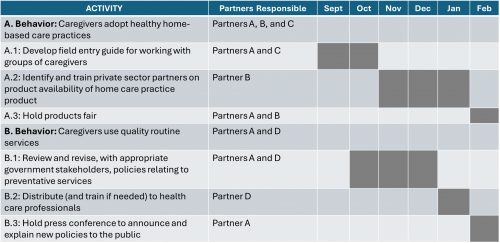A workplan keeps you on track when carrying out your activities. It provides a list of the extra tasks you might need to carry out for each strategy. And it reminds you exactly when and who will do them. For your behavior-led social and behavior change program it also requires that you detail: how each activity is connected to the priority behaviors; and what partners are responsible for changing which priority behaviors.
All workplans itemize what you will do and when you will do it. But with a behaviorally oriented workplan it’s also essential that the links to behaviors are maintained.
It’s all too easy to forget about your behaviors once you are in the middle of conducting your activities. It will be busy. It will be challenging. Let's face it…field work is tiring. How do you keep your behavioral focus when other practical issues feel more important? You pause. Breathe. And review your workplan before you get swept back up in the next attention-grabbing thing.
A workplan that clearly links your behaviors to activities reminds you that behaviors are at the heart of all you do. It also reminds your partners to stay focused on behaviors too.
It doesn’t take much to add this emphasis on behaviors into your workplan. Just a simple visual presentation can do the trick. Skip cataloging activities and tasks in the traditional way, as a long list of things to do by date. Instead, try adding the behavior(s) that the activities will change if carried out to the top of the list by behavior. Consider adding the factors that these activities are addressing by activity, so you also keep in mind the pathways to change for your program.
It’s small changes to your traditional workplan that will make a big difference. Just like small behavior change in the communities you care about can lead to big impacts. Funny how that works!
These changes are easily visible in your workplan. They will help you remember your behaviors on an ongoing basis. And these changes show others that your program is focused on behaviors. It’s as simple as that.
A six-month workplan that is behaviorally focused might look like this:
It shows the behaviors that are being changed. And it shows the partners involved in the activities to change those behaviors. Not much different than what you might normally do. But the constant reminder of your priority behaviors will help you maintain your behavioral focus.
If you want to go a step further, put the factors that each activity is working to overcome or leverage alongside each activity at the end, such as (see ending in italics and parenthesis):
- Identify and train private sector partners on product availability of home care practice products (insufficient availability of commodities).
Or, if you’d rather see the factors worded like your results framework sub-intermediate results, try something like (see ending in italics and parenthesis):
- Identify and train private sector partners on product availability of home care practice products (increased availability of commodities).
It doesn’t take much to keep your eye on the prize – changing your priority behaviors! Your workplan is another place that can help you do it.





 The Manoff Group was acquired by JSI in 2022.
The Manoff Group was acquired by JSI in 2022.